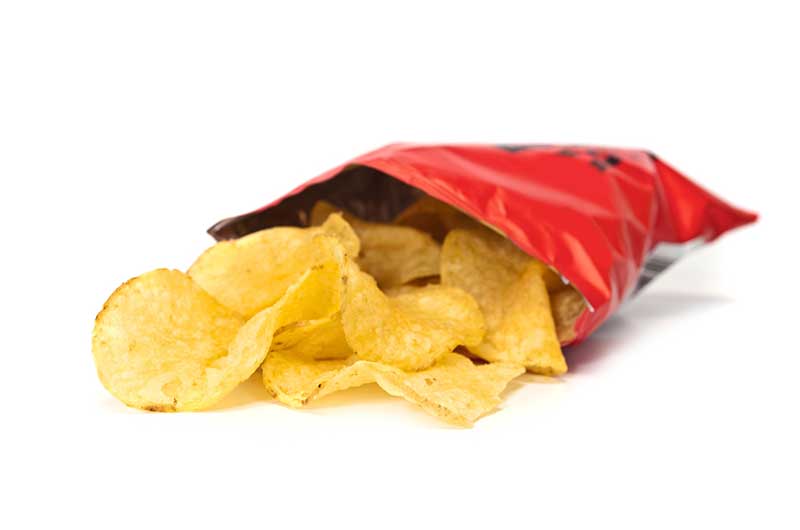Most snacking calories come from high salt, high fat and high calorie processed foods. These snack foods are cheap and convenient, yet they don’t offer much in the way of nutrition. It’s time to spring clean your kitchen and your diet by tossing these three food products and restocking your kitchen with healthier options.
Spring has sprung! And there’s no better time than the present to get cracking on cleaning up your diet. When it comes to minimizing junk foods and maximizing healthful foods at home, a quick look through your cupboards and refrigerator can be very telling. To give your diet an instant makeover, here are three food products to eliminate from your kitchen.
Packaged Snack Foods

If you’re a typical North American, you’re probably conditioned to think that snacks come out of bags. But if you can instead focus on eating whole foods for snacks, you’ll set yourself on a path to dietary progress.
USDA household data suggests that snacks contribute an average of 586 calories per day for men and 421 calories per day for women[i]. And you can assume most of those snacking calories come from high salt, high fat and high calorie foods that don’t contribute much else in the way of nutrition.
If you’re looking to lose weight, fruits and veggies can be your best snack friends. Aim to eat three serving of fresh fruit or veggies in between meals in lieu of processed snack foods. The high water and fiber content of fruits and veggies can help keep you full, and when you pair them with proteins like nuts, cheese or eggs, you’ll stay fuller for even longer.
Take a look through your pantry. Does it house snacks like potato chips, flavored popcorn, crackers or cookies? If so, ditch the junk in favor of these healthier snack foods:
- Unsalted nuts
- Fresh or unsweetened dried fruit
- Vegetables and hummus
- Peanut butter and whole wheat bread
- Hard boiled eggs
Flavored Yogurt

Yogurt tends to get an undeserved health halo. While it does contain calcium and other valuable nutrients, many commercial yogurt products also contain a lot of sugar and other added ingredients.
Here are a few useful tips to consider when perusing the yogurt aisle:
- Look for ingredient lists that include only milk and live active cultures.
- Select non-fat or low-fat plain yogurt if you’re looking to save calories.
- Many lower-calorie yogurts add sweetness with artificial flavors. Why not buy plain yogurt and add sweetness with fresh fruit?
Calorie-Laden Beverages

Food and beverage companies spend millions of dollars trying to convince consumers that their drinkable products are healthier than water. But for the vast majority of active, healthy Americans, water is your best bet when it comes to beverage choices.
There’s no hard and fast rule about how much water per day you need, but keeping an eye on the color of your urine is a good rule of thumb. Clear or light yellow urine means you are well hydrated; dark yellow urine means you need more water to dilute your body’s waste products.
Take a look at the labels of the drinks you currently consume. Chances are they are mostly water with added sugar and occasionally a small amount of vitamins you don’t need. You get ten times as much potassium from a banana than you do from a typical 12-ounce sports drink, with fewer calories and no added sugar, all at a fraction of the cost.
If consuming caffeine is part of your daily ritual, stick to tea and coffee, which are naturally calorie-free. Added sugars lurk in most bottled coffee and tea drinks, so be sure to read your labels carefully.
And what about juice? It’s always better to eat your fruit rather than drink it. Processing fruit into juice removes almost all of the pulp, which is where the fiber is housed. The resulting juice is a concentrated source of sugar without the benefit of fiber to slow its absorption.
What Should You Stash?
If you’re purging your refrigerator and pantry of added sugars and fats, you may be wondering what to stock instead. Your best bet is to stick with whole foods that can be consumed all by themselves or made into healthy meals and snacks.
Here are a few ideas for your newly overhauled grocery list:
- Fresh fruits and vegetables
- Nuts, seeds and legumes
- Whole grains and whole grain bread products
- Meat prepared without added sodium or sugary marinades
- Dairy foods that only contain dairy
References
[1] Sebastian, Rhonda S., Wilkinson Enns, Cecilia and Goldman, Joseph. “Snacking Patterns of US Adults, What We Eat in America,” Food Surveys Research Group Dietary Data Brief No. 4, https://www.ars.usda.gov/SP2UserFiles/Place/80400530/pdf/DBrief/4_adult_snacking_0708.pdf (June 2011).




 by
by 




 by
by